Key Takeaways
- In many organizations, the budding product management concept often becomes confused with project management, the Project Management Office, or service delivery.
- Using clear definitions of each role, product manager and project manager, and understanding the separate responsibilities helps inform appropriate expectations of goals and results.
- Proper alignment of the product management and project management roles helps both shine in a high-performance organization.
With the advent of the cloud and the massive transformation that cloud technology has brought to higher education, we also see the rise of product management concepts and product manager roles in the IT divisions of many institutions. In many organizations, however, the budding product management concept often becomes confused with project management, the Project Management Office (PMO), or service delivery. Few institutions have a dedicated role for the product manager.
The functions of project management and product management often overlap, resulting in misconceptions about the values and benefits each of these functions bring to the table. Also, a lack of clarity exists on the responsibilities of each of these roles, and often a lack of authority within the organizations for these roles prevents them from successfully achieving results. This article attempts to clarify some of these misconceptions and clearly distinguish the capabilities required for both of these functions.
First, let us start with a few definitions.
Project Management
Following are some definitions related to project management as defined by the Project Management Institute.
- Project: A temporary endeavor undertaken to create a unique product, service, or result
- Project Management: The application of knowledge, skills, tools, and techniques to project activities to meet project requirements
- Project Manager: A person assigned by the performing organization to achieve the project objectives; accountable for the outcome of the project
Product Management
Following are some definitions related to product management as defined by the Product Development and Management Association:
- Product: A term used to describe all goods, services, and knowledge sold. Products are bundles of attributes (features, functions, benefits, and uses) and can be either tangible, as in the case of physical goods, or intangible, as in the case of those associated with service benefits, or a combination of the two.
- Product Management: Ensuring over time that a product or service profitably meets the needs of customers by continually monitoring and modifying the elements of the marketing mix, including the product and its features, the communications strategy, distribution channels, and price.
- Product Manager: The person assigned by the organization to have responsibility for overseeing all of the various activities concerning a particular product.
A product is what you provide a group of users, whereas a project is a plan having a series of activities, a defined outcome, and fixed start and end dates.1
Say that your product is a new mobile application. It might require execution of many projects before it can be launched. These projects could be a discovery project to identify the key features for the mobile application; the actual development of the key features could be executed as a project; and finally, the marketing strategy and launch of the product itself can be its own project.
Product managers are often described as the CEOs of products, according to the Aha blog. Their goal is to deliver a product that customers love. Project managers, on the other hand, oversee a fixed project from start to end. Their goal is to work with a broader team with a diverse set of skill sets in order to complete a project on time and under budget.
In terms of responsibility, the Aha blog asserts that product managers own:
- Strategy
- Releases
- Ideation
- Features
- Go-to-market
- Organizational training
- Customer engagement
- Collaboration with engineering
- Product roadmap
- Support for the product
Whereas project managers own:
- Scope
- Budget
- Delivery
- Resources
- Capacity
- Application of processes and knowledge
- Cross-team organization
- Problem resolution
- Risk management
- Customer engagement
- Status updates
Scope
Both project and product managers work with customers to contain the scope. However, both would focus on different aspects of the scope. The project manager focuses on "How" (work-oriented), whereas the product manager focuses on the "What" (functional requirements-oriented).
One challenge of the two roles with respect to scope is that they can appear to be at odds with each other. A product manager may want to add features to meet observed customer needs, while the project manager may want to keep scope as small as possible so that the project is delivered on time and under budget. Good product managers and good project managers create a balance of these conflicts. Good project managers know that the true success of a project is not whether it is on time and within budget, but whether it meets the defined goals and objectives. Good product managers know that all the features in the world will not matter if the project is continually delayed and never makes it to market or if it is too much over budget to be completed.1
Project Management vs. Product Management Framework
A typical project starts with initiation and goes through planning, execution, and control, with the final phase being closure of the project. Figure 1 depicts the key knowledge areas on which the project management framework focuses within the various phases of the project lifecycle.

Source: PMI PMBOK v5
Figure 1. Key knowledge areas of focus within the project phases
A typical product starts with its introduction and goes through growth, maturity, and finally decline in its product lifecycle. Figure 2 shows the seven phases of the product lifecycle and the key knowledge areas on which the product management framework focuses during that cycle.
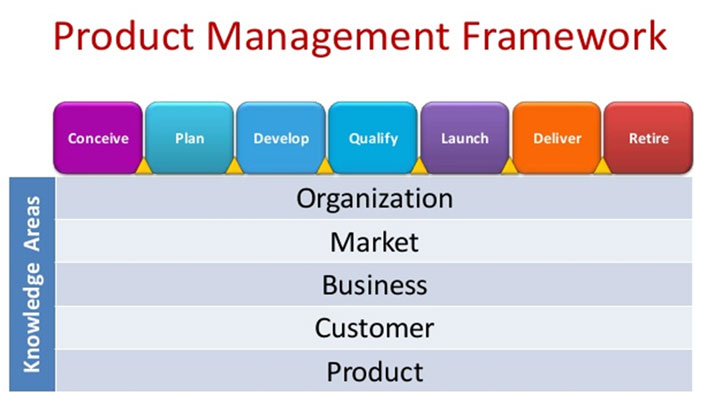
Source: AIPMM ProdBOK® © 1998–2017. All Rights Reserved.
Figure 2. Key knowledge areas of focus within the product's phases
When we integrate both these frameworks, as in figure 3, you can see there could be multiple project executions within the product lifecycle, starting from Conceive and Plan, Develop and Qualify, Deliver, and Retire.


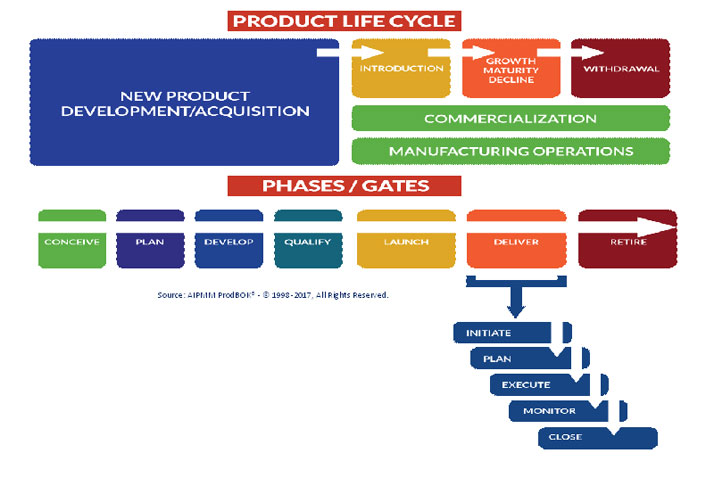
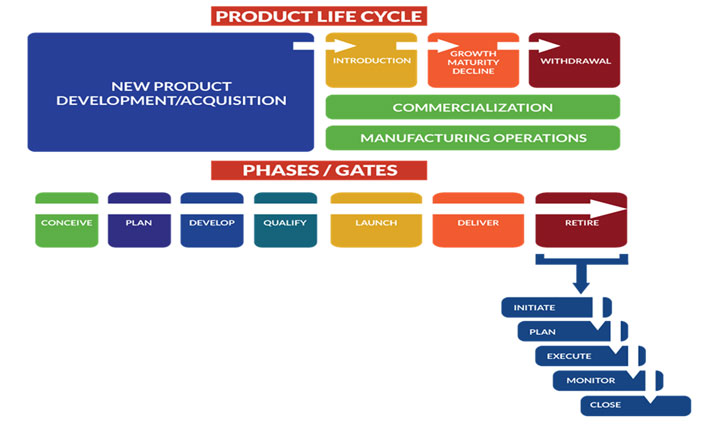
Figure 3. Multiple possible project executions within the product lifecycle
Key Deliverables Comparison
Figure 4 provides a brief look at the key deliverables when comparing project management and product management.
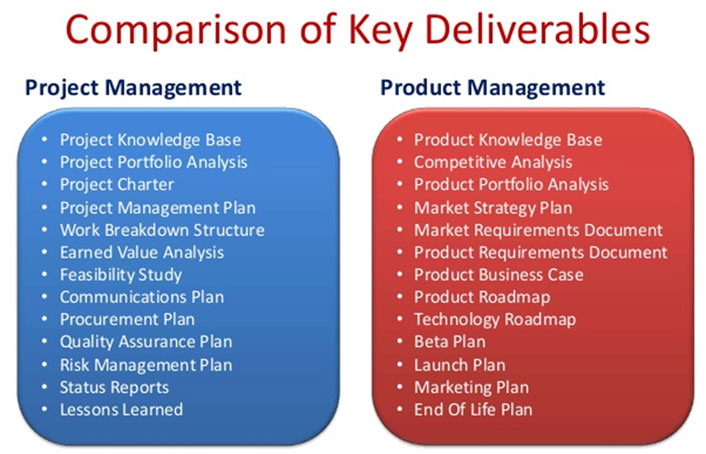
Source: AIPMM ProdBOK® © 1998–2017. All Rights Reserved.
Figure 4. The key deliverables of project management vs. product management
Product Manager in Higher Education
The definitions and frameworks used in this article for both project management and product management come from the PMI and Product Development and Management Association, respectively. Both, particularly the product management definitions and framework, focus on the corporate world, where a product manager is responsible for developing a new product and launching a marketing campaign to introduce it into the market to generate new or expand existing revenue streams. That is not typical in higher education.
In higher education a product manager is usually an owner of a vendor-provided third-party software-as-a-service (SAAS) application. The product manager also serves as a user advocate and is responsible for providing better experiences with the service to users. These product managers are also accountable for the entire service offering lifecycle and for the success of the offering without owning the product development part. Hence these product managers' success depends on well-defined vendor relationships and their ability to successfully advocate for user needs, and then match these needs with the appropriate third-party services. Figure 5 shows a product lifecycle in higher education as defined by the University of Notre Dame.2
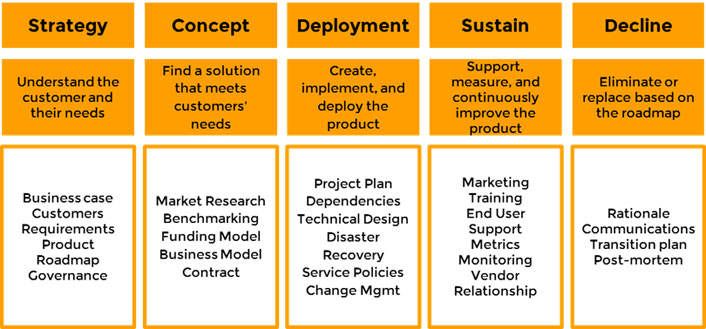
Source: Chas Grundy. Used with permission.
Figure 5. Notre Dame–inspired product lifecycle in higher education
However, we could still map the general product management framework defined by the Product Development and Management Association to the typical role played by product managers in higher education, as shown in table 1.
Table 1. Comparison of industry and higher ed product manager roles
|
Product Development and Management Association Framework Phases |
University of Notre Dame Product Lifecycle Phases |
|---|---|
|
Conceive |
Strategy, Concept |
|
Plan, Develop, Qualify, Launch |
Deployment |
|
Deliver |
Sustain |
|
Retire |
Decline |
As you can see, even though a product manager in higher education does not have the responsibility of pricing, marketing, and generating revenue streams, they still would need to negotiate the pricing with the vendor to contain the cost of the service for the campus, market the product to the campus users, and create added value for the campus business users by taking ownership of the service and maintaining a close coordination with the vendor.
Common Responsibilities, Unique Functions
Aside from the differences, the responsibilities overlap between the two positions of product manager and project manager. Following are some of the common responsibilities for both positions, with both roles:
- Aligning activities performed by cross-functional teams with strategic objectives
- Requiring strong influential and collaborative skills to guide critical decisions
- Orchestrating key activities and managing key deliverables
- Working with campus stakeholders who use the product, the product team, and executive management
Despite of the common responsibilities, however, product managers and project managers both perform unique functions. When aligned properly, the organization can benefit. For example, project managers guide key decisions to maximize quality and minimize risk, whereas product managers guide key decisions to maximize value for customers and/or create new revenue streams. Both roles work closely together in a high-performing organization. Each sees the same work through a different lens, but they work for the same team. When the project and product managers join forces to collaborate, everyone in the higher ed IT organization wins.
Notes
- Andre Muscat, "Product Manager Struggles in Project Management Roles," LinkedIn, August 8, 2014.
- Chas Grundy, presenting with Mary-Beth Stuenkel, "Who's in Charge Here? The New Role of Product Management," EDUCAUSE Annual Conference 2015 program, October 28, 2015, 43.
Hemalatha Manickavinayaham, PMP, MBA, is IT project manager principal, Enterprise Information Systems, Office of Information Technology, Georgia Institute of Technology.
© 2017 Hemalatha Manickavinayaham. The text of this article is licensed under Creative Commons BY-NC-ND 4.0.
